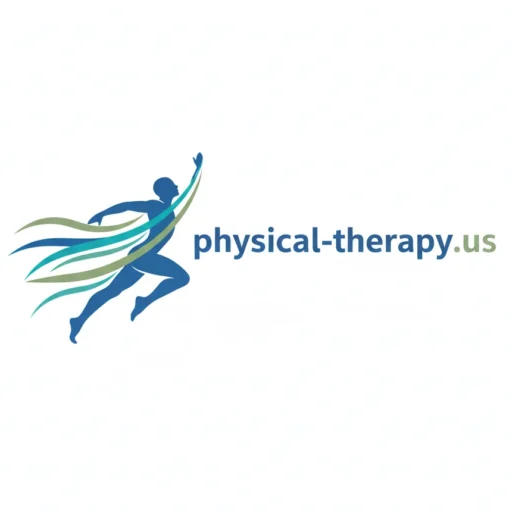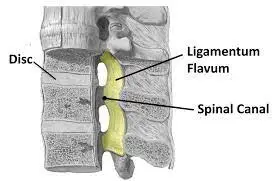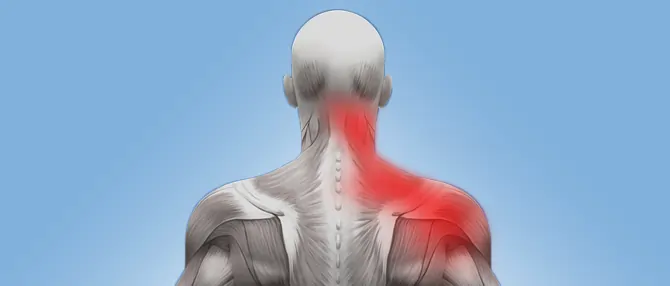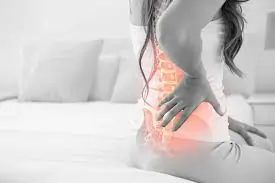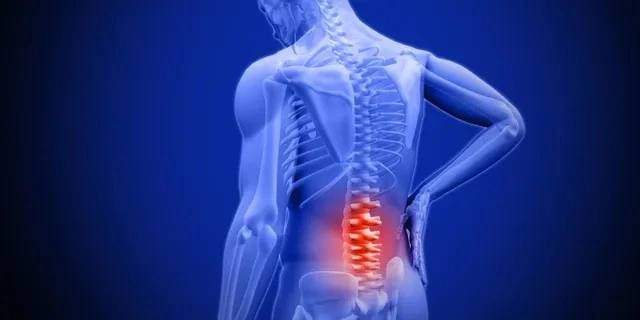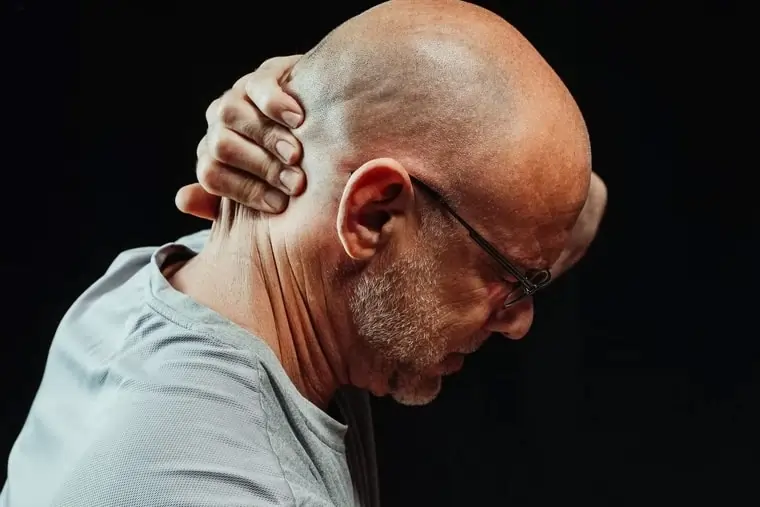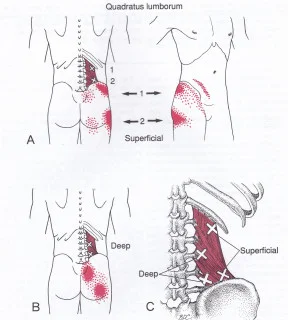Ligamentum Flavum Injury
Introduction:
The ligamentum flavum is a strong, elastic ligament that connects the laminae of adjacent vertebrae, playing a crucial role in maintaining spinal stability and posture. Injury to this ligament, often due to trauma, repetitive strain, or degenerative changes, can lead to thickening or hypertrophy, potentially compressing nearby nerves or the spinal cord.
This may result in symptoms like back pain, stiffness, or neurological deficits, commonly associated with conditions such as spinal stenosis.
Rest, physical therapy, painkillers, and in extreme situations, surgery, are all possible forms of treatment. Ligamentum Flavum injuries can be prevented by practicing proper posture and avoiding activities that overstress the spine.
Pathology of the Ligamentum Flavum:
Numerous medical disorders can impact the Ligamentum Flavum, resulting in spinal dysfunction and pain. Among these conditions are:
- Ligamentum flavum’s real cause is hypertrophy. Collagen type IV deposition, elastin fragmentation, and calcification of cartilage and elastin are all issues related to hypertrophy. An age-related condition known as hypertrophy of ligamentum flavum occurs when the ligamentum flavum’s elastin-to-collagen ratios decrease. It can occur at any age, though it is frequently seen in older adults.
- Neglecting small injuries is the main cause. The term “hypertrophy” describes the Ligamentum Flavum’s aberrant enlargement, which can compress the spinal cord and nerve roots. Symptoms including leg paralysis, numbness, and lower back pain could arise from this.
- Degeneration: Aging or wear and tear can cause the Ligamentum Flavum to degenerate. Instability in the spine may result from the ligament being weaker and less flexible.
- Calcification: The accumulation of calcium salts in the ligament may result in calcification of the Ligamentum Flavum. The spinal cord and nerve roots may be compressed as a result of the ligament becoming rigid and inflexible.
- Ossification: The development of bone inside the ligament is referred to as osseification of the Ligamentum Flavum. Compression of the spinal cord and nerve roots may result from this, causing symptoms such limb weakness, numbness, and back pain.
- Trauma: Damage to the Ligamentum Flavum from spinal trauma can result in instability and dysfunction in the spine.
Symptoms of the Ligamentum Flavum Injury:
The degree and location of the pathology determine the Ligamentum Flavum symptoms.
When there is ligamentum flavum hypertrophy in the neck, certain symptoms and indicators appear.
- Although it is extremely dangerous, the neck is the second most common location for ligamentum flavum overgrowth.
- Serious spinal canal stenosis or myelopathy may result from a neck ligamentum flavum that is excessively thickened or hypertrophied. Myelopathy from severe canal stenosis in the neck can cause severe sensations. Severe spinal cord compression, or myelopathy, is frequently caused by degeneration, trauma, congenital abnormalities, or hypertrophy. From the neck down to the feet, malfunctioning symptoms may be seen. Paralysis from the neck down may be the outcome.
But some typical signs and symptoms are as follows:
- Back pain: Ligamentum Flavum disease frequently manifests as lower back pain. The pain may radiate to the buttocks, hips, or legs, or it may be isolated.
- Numbness and tingling: Numbness and tingling in the legs, feet, and toes may result from compression of the spinal cord and nerve roots.
- Weakness: One of the most typical signs of Ligamentum Flavum pathology is weakness in the legs. One or both legs may be affected, and the weakness may be minor or severe.
- Loss of balance: The ability to balance and coordinate movements may be impacted by spinal cord compression.
- Bowel and bladder dysfunction: In extreme situations, spinal cord compression may result in these problems.
- Radiculopathy: Pain, numbness, and weakness in a particular area of the body are symptoms of radiculopathy, which can be caused by compression of the nerve roots.
- Spinal stenosis: This condition is characterized by the narrowing of the spinal canal and can be caused by Ligamentum Flavum hypertrophy, degeneration, calcification, or ossification. This may result in compression of the spinal cord and nerve roots.
If you have any of these symptoms, it is imperative that you seek medical attention because they may be signs of a dangerous underlying disease.
Risk factors of Ligamentum Flavum Injury:
The ligamentum flavum is a robust and pliable ligament that joins the spine’s vertebrae. It is found in the spinal canal and contributes to the spine’s stability. On the other hand, some risk factors may make ligamentum flavum pathology more likely to occur, which may result in pain and other symptoms. Among these risk factors are the following:
- Age: The ligamentum flavum may thicken and become more fibrous with age, which may cause the spinal canal to narrow and the spinal nerves to be compressed.
- Genetics: Some individuals may be more prone to ligamentum flavum pathology due to a genetic predisposition to the condition.
- Obesity: Carrying too much weight can strain the ligamentum flavum and raise the chance of developing disease by putting extra strain on the spine.
- Trauma: Damage to the ligamentum flavum from spinal injuries such whiplash or falls can result in pathology.
- Repetitive stress: Over time, the ligamentum flavum may deteriorate as a result of repetitive motions or activities that strain the spine, such as bending or heavy lifting.
- Bad posture: Bad posture when standing or sitting might increase the chance of developing disease and place additional strain on the ligamentum flavum.
- Spinal disorders: Compression of the ligamentum flavum can result in pathology in some spinal disorders, such as spinal stenosis or ruptured discs.
By being aware of these risk factors, people can lower their chance of having ligamentum flavum pathology. Protecting the ligamentum flavum and preserving spinal health can be achieved by keeping a healthy weight, adopting proper posture, avoiding repetitive strain on the spine, and getting aid for any spinal injuries or diseases as soon as possible.
Diagnosis:
Imaging studies, physical examinations, and medical histories are usually used in conjunction to diagnose Ligamentum Flavum pathology. Inquiries concerning the beginning, course, and intensity of symptoms, as well as any relevant diseases or previous procedures, will be part of the medical history.
The doctor will evaluate reflexes, sensitivity, muscular strength, and spine range of motion during the physical examination. Additionally, they could conduct particular tests to check for compression of the spinal cord or nerve roots.
In order to confirm the diagnosis and ascertain the location and severity of the pathology, imaging tests are usually conducted. These could consist of:
- X-rays: X-rays can reveal bone abnormalities such fractures, degenerative changes, or spinal stenosis.
- MRI stands for magnetic resonance imaging, which creates fine-grained pictures of the body’s soft tissues, such as ligaments, discs, and nerves, using strong magnets and radio waves. In addition to spinal cord compression and ligamentum flavum hypertrophy or ossification, it may exhibit herniated discs.
- Computed tomography, or CT, scans provide fine-grained pictures of the soft tissues and bones using X-rays and computer technology. It may display bone anomalies such fractures or spinal stenosis.
- Myelogram: To increase the visibility of the spinal cord and nerve roots on X-rays or CT scans, a contrast dye is injected into the spinal canal.
The location and degree of the pathology will determine the available therapy options when a diagnosis has been determined. Painkillers, physical therapy, and rest can all be used to treat mild cases. Surgery may be necessary in more severe cases in order to decompress the spinal cord or nerve roots.
Treatment of the Ligamentum Flavum Injury:
Medical Treatment:
Non-surgical techniques are used in conservative therapy of ligamentum flavum pathology in order to control symptoms and delay the disease’s progression. For mild to severe cases of ligamentum flavum hypertrophy or ossification, this method is usually advised.
- Rest: Putting the spine to rest can help lower inflammation and ease pain. Patients may be counseled to avoid from activities like heavy lifting and extended sitting that worse their symptoms.
- Physical therapy: Physical therapy can assist increase the spine’s range of motion, strength, and flexibility. Exercises to strengthen the core muscles, enhance posture, and lessen strain on the spinal cord or nerve roots may be suggested by the therapist.
- Drugs: To treat pain and muscle spasms, doctors may give painkillers such muscle relaxants or nonsteroidal anti-inflammatory medicines (NSAIDs).
- Injections of corticosteroids into the epidural area have been shown to help reduce inflammation and alleviate pain. Patients with moderate to severe symptoms who don’t improve with other treatments are usually the ones who get this medication.
- Bracing: To provide stability and support to the spine, a back brace could be recommended. This can ease pain and lessen strain on the ligamentum flavum.
Not all individuals with ligamentum flavum pathology respond well to conservative treatment, particularly if their symptoms are severe or their condition is progressing. Surgery can be required in these situations in order to decompress the spinal cord or nerve roots and stop additional harm. To choose the best course of action for each unique disease, it is crucial to go over all available treatment choices with a healthcare professional.
Physical Therapy Treatment:
In order to increase spinal mobility, lessen pain and inflammation, and strengthen the muscles that support the spine, physical therapy treatment for ligamentum flavum disease combines manual therapy techniques with exercises. Based on the patient’s unique needs and objectives, the physical therapist will evaluate their health and create a personalized treatment plan.
- Stretching exercises: To increase the spine’s range of motion and flexibility, the physical therapist could suggest stretching exercises. These exercises can ease pain and lessen strain on the ligamentum flavum. Stretches for the hamstrings, hip flexors, and spine are a few types of stretching exercises.
- Strengthening exercises: Strength training can help to increase the spine’s support and stability. Exercises to strengthen the back and abdominal muscles are among the core muscles that the physical therapist could suggest. Back extensions, bridges, and planks are a few types of strengthening exercises.
- Manual therapy: Massage, mobilization, and manipulation are examples of manual therapy procedures that can help lower pain and increase spinal mobility. To relieve stress in the muscles and soft tissues and apply pressure to the affected area, the physical therapist may use their hands or specialized equipment.
- Posture correction: Ligamentum flavum pathology can arise as a result of poor posture. The physical therapist could suggest posture-enhancing exercises and methods including postural taping, ergonomic modifications, and instruction in good body mechanics.
- Modalities: To lessen pain and inflammation in the affected area, modalities like electrical stimulation, ultrasound, and heat or cold therapy may be applied.
The severity of the problem and the patient’s specific demands will determine how long and how often physical therapy is used to treat ligamentum flavum pathology. In certain situations, continuing maintenance treatment could be required to stop the symptoms from returning. Patients should maintain their home care regimen and exercises as directed by their physical therapist in order to get the greatest results possible.
Prevention of Ligamentum Flavum injuries:
Reducing the risk factors that may lead to the pathology of the ligamentum flavum is necessary to prevent injury to this structure. The following advice will help you avoid ligamentum flavum injuries:
- Maintain a healthy weight: Keep your weight within a reasonable range because too much weight strains the spine and can damage the ligamentum flavum. This pressure can be lessened and the ligamentum flavum can be protected by maintaining a healthy weight through food and exercise.
- Practice good posture: Maintain proper posture whether sitting or standing to lessen the strain on the ligamentum flavum and other spine components. This entails sitting or standing with the chin up, shoulders back, and chest out.
- Avoid repetitive stress on the spine: Over time, the ligamentum flavum may deteriorate due to repetitive motions or activities that strain the spine, such as bending or heavy lifting. Protecting the ligamentum flavum can be achieved by avoiding certain activities or by taking breaks to stretch and move.
- Wear appropriate footwear: Shoes that are supportive and cushioned can lessen the force on the spine and shield the ligamentum flavum.
- Seek prompt treatment for spinal injuries or conditions: Spinal injuries like whiplash or falls can harm the ligamentum flavum and cause disease. The ligamentum flavum can be protected and more harm can be avoided by seeking treatment for these injuries as soon as possible. Furthermore, preventing pathology and lessening the strain on the ligamentum flavum can be achieved by treating spinal disorders such spinal stenosis or ruptured discs.
People can preserve spinal health and protect their ligamentum flavum by heeding these recommendations.
Prognosis:
The severity of the injury and the course of treatment determine the prognosis for Ligamentum Flavum injuries. Conservative treatment for mild injuries, such as physical therapy and medicines, frequently results in a full recovery.
On the other hand, severe hypertrophy or chronic degeneration may result in chronic problems that occasionally call for surgery. In addition to improving results, early diagnosis and suitable therapy help avoid long-term issues like spinal stenosis and nerve compression.
Complications of Ligamentum Flavum injuries:
- Spinal Stenosis: Nerve compression can result from spinal stenosis, which is caused by hypertrophy or scarring that narrows the spinal canal.
- Chronic Pain: Long-term pain can be caused by persistent inflammation and degradation.
- Radiculopathy: Compression of the nerve roots may result in limb weakness, numbness, or radiating pain.
- Myelopathy: In severe situations, motor and sensory functioning may be affected by spinal cord compression.
- Reduced Spinal Stability: Aberrant spinal movement and instability may be caused by ligament damage.
- Postural Changes: Long-term problems can cause the alignment of the spine to change, which can impact posture and movement.
- Surgical Risks: If surgery is necessary, risks like infection, nerve injury, or the development of scar tissue could occur.
Conclusion:
In conclusion, Ligamentum Flavum injuries, especially those linked to trauma, degenerative alterations, or hypertrophy, can result in severe spinal instability, pain and neurological impairments. These injuries may worse diseases like nerve compression and spinal stenosis, which call for conservative treatment with physical therapy, medication, and lifestyle changes.
In extreme situations, surgery can be required to alleviate symptoms and regain function. For the best possible recovery and to avoid long-term problems, early diagnosis and adequate treatment are essential.
FAQs
What kind of surgery is used to thicken the ligamentum flavum?
Flavum Ligamentum The goal of thickening, or hypertrophy, surgery is to remove the thickened ligament, usually by laminectomy or minimally invasive decompression, in order to relieve pressure on the spinal cord and nerves.
How does Ayurveda cure ligamentum flavum hypertrophy?
In order to address the underlying imbalances and relieve symptoms, Ayurveda treats ligamentum flavum hypertrophy, a disorder that causes spinal stenosis, holistically. This includes Panchakarma treatments, herbal medicines, and lifestyle changes.
What causes ligamentum flavum inflammation?
The primary reasons are age, long-term bad posture, and chronic strain from repetitive motions or heavy lifting. These elements play a part in the degenerative processes affecting the spine, which cause the ligament to thicken.
How does ligamentum flavum get treated?
Shockwave therapy, therapeutic ultrasound, high-intensity laser therapy, and non-rotatory chiropractic procedures like the Activator Method are among the available treatments. These techniques are combined with spinal decompression in our unique NSD Therapy to effectively treat ligament thickening and related disorders.
What role does the ligamentum flavum play in medicine?
The ligamentum flavum is responsible for maintaining erect posture. It aids in straightening the column following flexion and maintaining the spine’s natural curvature. But as we age, the ligamentum flavum’s flexibility declines, which could be linked to buckling and hypertrophy.
What symptoms and indicators indicate ligamentum flavum ossification?
It is rare for Caucasians to have ligamentum flavum ossification, a prominent cause of thoracic stenosis in the Japanese population. Leg pain and numbness are the most prevalent initial symptoms, followed by paraparesis; trunkal pain is a first symptom in a small percentage of individuals.
Which movement is limited by the ligamentum flavum?
Limitations in spinal flexion (bending forward), particularly unconscious flexion, are caused by the ligamentum flavum. This function ensures that your discs are protected from harm by the ligamentum flavum.
Is it possible to avoid ligamentum flavum hypertrophy?
Although there is no surefire method to stop ligamentum flavum enlargement, spinal issues can be avoided by exercising frequently, employing safe lifting techniques, and keeping a healthy posture.
How is ligamentum flavum hypertrophy treated medically?
Physical therapy, pain management, and, in extreme situations, surgery to remove a section of the ligament to relieve pressure on the spinal cord or nerve roots are all possible treatments for ligamentum flavum hypertrophy.
How is hypertrophy of the ligamentum flavum diagnosed?
MRIs, CT scans, and X-rays are common imaging techniques used to diagnose ligamentum flavum hypertrophy.
What symptoms indicate ligamentum flavum hypertrophy?
Limited mobility, stiffness, and back pain are some signs of ligamentum flavum hypertrophy. In extreme situations, it may compress the spinal cord or nerve roots, resulting in symptoms like weakness, tingling, numbness, and trouble walking.
What leads to hypertrophy of the ligamentum flavum?
Age, degenerative changes in the spine, or recurrent strain on the ligament can all lead to ligamentum flavum hypertrophy.
What is the location of the ligamentum flavum?
The ligamentum flavum is situated in the space between neighboring vertebral laminae in the spinal column.
What are the ligamentum flavum’s primary features?
The ligamentum flavum contributes to the stability and support of the spine. By stopping the vertebrae from moving too much, it also aids in protecting the spinal cord.
The ligamentum flavum: what is it?
The ligamentum flavum is a robust, pliable ligament that joins the spine’s vertebrae.
References
- Patel, D. (2023c, August 26). Ligamentum flavum – anatomy, structure, function. Samarpan Physiotherapy Clinic. https://samarpanphysioclinic.com/ligamentum-flavum/
- Physiotherapy, C. (2024, February 10). Stressed Spine, Stiff Movements? Relieve Ligamentum Flavum Hypertrophy with the Help of Physiotherap. cbphysiotherapy. https://cbphysiotherapy.in/blog/stressed-spine-stiff-movements-relieve-ligamentum-flavum-hypertrophy-with-the-help-of-physiotherapy
